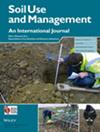不同水溶性磷对中国新疆玉米中磷的分布和利用的影响
IF 3.7
3区 农林科学
Q1 SOIL SCIENCE
引用次数: 0
摘要
磷(P)是农业中的主要限制性养分。由于磷在土壤中的移动和转移能力较弱,施入土壤中的大部分磷肥仍然无效。目前的农业生产需要施用大量的磷肥,导致土壤中残留磷的积累和严重的生态问题。磷的固定是肥效有限的重要原因。因此,提高土壤中 P 的有效性是减少土壤中 P 累积的关键。本研究通过比较中国新疆石灰性土壤中土壤磷的分布与玉米对磷的吸收利用之间的关系,探讨了不同水溶性磷肥对玉米产量和经济效益的影响。主要结果表明:(1)滴施多磷酸铵(APP)和磷酸脲(UR)更有利于提高土壤深层总磷含量;滴施多磷酸铵(APP)有利于提高土壤深层可利用磷含量。(2)滴施酸性肥料更有利于降低土壤酸碱度(pH 值)。(3)施用不同的钾肥有利于钾在玉米各器官中的积累,其中 APP 和 UP 的效果最好,与 CK(不施钾肥)相比,它们分别增加了 75.8%和 60.4%(开花期)以及 98.2%和 62.3%(成熟期)的钾积累。(4)pH 值是影响钾吸收和转化的主要因素,滴施钾肥对 pH 值的影响最大。(5)施用不同的水溶性磷肥可提高玉米产量和经济效益。在本研究选择的五种水溶性磷肥中,APP的经济效益最大,其次是UP和磷酸一铵(MAP);与CK相比,它们分别增产31.6%、24.5%和22.0%。本文章由计算机程序翻译,如有差异,请以英文原文为准。
Effects of Different Water‐Soluble Phosphorus on the Distribution and Utilization of Phosphorus in Maize in Xinjiang, China
Phosphorus (P) is the main limiting nutrient in agriculture. Most of the P fertilizers applied to the soil remain ineffective because of the weak movement and transfer of P in the soil. Current agricultural production requires large amounts of P fertilizers, leading to the accumulation of residual P in the soil and serious ecological problems. Fixation of P is a vital reason for limited fertilizer effectiveness. Therefore, improving soil P effectiveness is the key to reducing soil P accumulation. This study explored the effects of different water‐soluble P fertilizers on maize yield and economic benefits by comparing the relationships between soil P distribution and P absorption and utilisation of maize in a calcareous soil of Xinjiang province in China. The main results indicated that (1) the drip application of ammonium polyphosphate (APP) and urea phosphate (UR) was more beneficial for increasing the total P content in the deep soil layer; the drip application of APP was beneficial in increasing the available P content of the deep soil layer. (2) Dripping acid fertilizer was more conducive to reducing soil acidity and alkalinity (pH). (3) The application of different P fertilizers favoured the accumulation of P in all organs of maize, among which APP and UP were the most effective since they increased accumulation by 75.8% and 60.4% (at flowering stage) and 98.2% and 62.3% (at maturity stage), respectively, compared with CK (without P fertilizer). (4) pH was the main factor affecting P uptake and transformation, and the drip application of P fertilizer had the most significant effect on pH. (5) The application of different water‐soluble P fertilizers increased maize yield and economic benefits. Among the five water‐soluble P fertilizers selected in this study, APP had the greatest economic benefits, followed by UP and Monoammonium phosphate (MAP); they increased yields by 31.6%, 24.5%, and 22.0%, respectively, compared with CK.
求助全文
通过发布文献求助,成功后即可免费获取论文全文。
去求助
来源期刊

Soil Use and Management
农林科学-土壤科学
CiteScore
7.70
自引率
13.20%
发文量
78
审稿时长
3 months
期刊介绍:
Soil Use and Management publishes in soil science, earth and environmental science, agricultural science, and engineering fields. The submitted papers should consider the underlying mechanisms governing the natural and anthropogenic processes which affect soil systems, and should inform policy makers and/or practitioners on the sustainable use and management of soil resources. Interdisciplinary studies, e.g. linking soil with climate change, biodiversity, global health, and the UN’s sustainable development goals, with strong novelty, wide implications, and unexpected outcomes are welcomed.
 求助内容:
求助内容: 应助结果提醒方式:
应助结果提醒方式:


